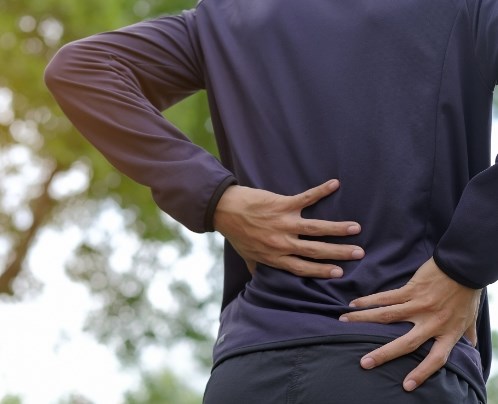Education is key when it comes to recognizing and treating lower back pain.
That’s according to Chad Watters, registered physiotherapist and owner of Lake Country Physiotherapy in Orillia.
Although back pain has been around as long as people have been mobile, Watters says that these days, more people are seeking care for chronic injuries.
That could be an increase in people’s ability to research what ails them – just Google “back pain” and you’ll find a host of symptoms, causes and treatments – but it could also be a change in lifestyle, especially when it comes to work.
“The rise of virtual work has led to people working from home without appropriate workstations,” Watters said. “Back pain doesn’t happen to everybody, but if they’re working for prolonged periods, you’ll see it more often.”
The pandemic, Watters said, with its ensuing lockdowns and shifting to work-from-home models, put a strain on our collective bodies.
“We have seen a number of people where it's not just their back, but it could be their neck, it could be nerve symptoms down into their hands,” Watters said. “That seems to be the trigger that we can come up with, that it's the change to virtual working.”
But it’s not all doom and gloom for those experiencing low back pain.
There’s a complex system behind how the body moves and how it reacts and adapts to pain, and physiotherapists, like those at Lake Country Physiotherapy, take a holistic, comprehensive approach to keeping your body strong.
“The brain is very complex,” Watters said. “If it's had pain for a long time in one area, it learns that pain is there. Sometimes it can increase the importance of that pain, or it can also perpetuate that pain, even though the body has been healing that pain site..”

What are the signs to look for?
“People present with a full gamut,” Watter said. “There are people who have nerve symptoms down into their legs. That could be a tingling, numbness, it could be pain, it could be weakness.”
Others present with more typical back pain.
“The client will say ‘I have back pain, it takes two hours of sitting to cause the pain’ or the pain only occurs after they’ve gone on a long walk,” Watters said.
The key is, Watters said, to make sure staff is getting the full picture of a person’s health before treatment. That includes figuring out what’s turning the pain on, and eventually suggest a plan to turn it off.
“At your first appointment, you're going to be asked a number of questions by the physiotherapist because we need to get to know how the pain affects you,” Watters said. “We need to know whether this pain is mechanical, i.e., do you move to one particular portion and create it? Or is the pain just there, the same way, no matter how you're moving.”
Other factors they look at may come as a surprise to those who think pain is just about muscle aches or stiff joints.
“What other factors in your life could be leading to some of this?,” Watters said. “It's not just mechanics, it could be that life things that have changed, that are affecting you emotionally, or psycho-socially, your relationships with other people or job losses, etc.”
“All of those things play into your back pain.”
A brief history of back pain
Back pain is estimated to be experienced by between 4 per cent and 25 per cent of the Canadian population.
According to Bone and Joint Canada, the cost of medical expenditures alone for low back pain are estimated between $6 and $12 billion annually. Additional costs associated with the impact on society due to the loss in worker productivity from time off work and the associated disability payments compound the problem.
And recent research from Australia is casting a bit of doubt on the effectiveness of opioids on treating the root problems of back pain. The key takeaway from the study is that doctors should reconsider prescribing opioids for acute non-specific low back pain or neck pain given that the researchers “found no significant difference in pain severity compared with placebo.”
That’s where a tailored physiotherapy program – with clear expectations set for the patient – can come into play.
“If we see something where it's a muscular problem, and we think we can fix it quickly, we would tell them so,” Watters said.
That includes pain stemming from disc injuries, where data shows that 80 per cent of disks heal in six weeks, if the person isn’t aggravating the injury. 90 per cent see an improvement in 12 weeks.
“If you tell patients that, they’re receptive as long as you communicate that initially there's going to have to be work done here, we're going to emphasize certain activities,” Watters said.
“One of our big keys is making sure the person is not afraid of motion. Motion is really what's going to end up healing it.”
Watters and the staff at Lake Country Physiotherapy are open for new clients. Please visit their web page by clicking here, or follow the team on Facebook.
Things to watch out for:
Lower back pain may manifest in various ways. Some common signs include:
1. Constant or intermittent dull aches in the lower back region.
2. Sharp or shooting pains that may worsen with movement.
3. Pain radiating down to the buttocks, thighs, or legs.
4. Stiffness or reduced flexibility in the lower back.
5. Muscle spasms or tenderness around the affected area.
Causes of Lower Back Pain
There are several factors that may contribute to lower back pain. Some common causes are:
1. Sprains and strains: Overstretching or tearing the muscles and ligaments in the lower back can cause strain injuries that lead to severe pain.
2. Poor posture: Sitting or standing for long periods with incorrect posture can cause muscle imbalances and induce strain on intervertebral discs, resulting in lower back discomfort.
3. Stenosis/Narrowing of spinal spaces: The natural aging process may result in wear and tear of the joints, discs, and ligaments of the spine leading to narrowing. This can lead to discomfort in the spine or pain into one or both legs.
4. Herniated discs: Discs, which cushion the vertebrae in your spine, can rupture through weakened outer layers, leading to nearby nerves being pressed upon, resulting in severe pain.
